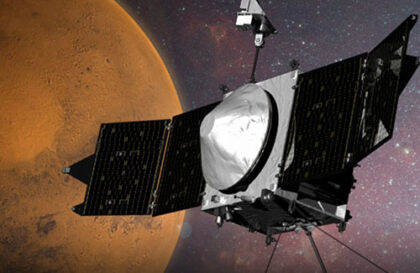Scientists using the Neutral Gas and Ion Mass Spectrometer (NGIMS) aboard NASA’s MAVEN spacecraft have found that water vapor on Mars reaches higher levels of the atmosphere than expected. At these altitudes, water quickly decomposes under the influence of ionized gas particles and is lost into outer space.
Researchers believe this process has contributed to Mars losing a volume of water comparable to the depth of the global ocean up to hundreds of meters over the past billions of years. A paper published on November 13, 2020, in the journal Science states that water loss continues today due to the movement of water vapor to high altitudes due to the sublimation of glaciers during the warm months.
Shane W. Stone of the University of Arizona in Tucson says they were surprised to find water so high in the atmosphere. MAVEN made These unique measurements possible as it flew through the Martian atmosphere. The NGIMS mass spectrometer inhales air and separates its constituent ions by mass, which is how scientists identify them.
The NGIMS instrument measures the composition and isotopes of thermal neutrals and ions in the Martian atmosphere. Credit: NASA/GSFC
Dust storms disrupt the water cycle on Mars
Credits: NASA
Stone and his colleagues analyzed the abundance of water ions at an altitude of approximately 90 miles (150 km) above the surface of Mars over two Martian years. They found that the highest water vapor content in the upper atmosphere is observed in the summer in the southern hemisphere when Mars is at its minimum distance from the Sun and encounters dust storms.
Under the influence of summer heat and winds associated with dust storms, water vapor rises to the top of the atmosphere. There, it splits into hydrogen and oxygen, disappearing into space. It was previously thought that water vapor, like on Earth, was predominantly concentrated near the planet’s surface.
Stone argues that the upper atmospheres of Mars and Earth are exposed to direct sunlight, so all substances there are quickly destroyed.
How Water is Lost on Mars: This illustration shows how water is lost on Mars normally vs. during regional or global dust storms. Credits: University of Arizona/Shane Stone/NASA Goddard/Dan Gallagher.
During a massive dust storm in June 2018 that grounded and deactivated the Opportunity rover, scientists noticed a 20-fold increase in water content in the Martian atmosphere. In 45 days of this storm, the planet lost as much water as is usually lost in an entire Martian year, equal to two Earth years.
Paul Mahaffey, director of Solar System Exploration at NASA Goddard, noted that dust storms cause water molecules to rise into the upper atmosphere of Mars. They undergo chemical reactions, releasing hydrogen, which is then lost into space.
Until recently, scientists realized that Martian dust storms could spread water vapor into the atmosphere but did not realize that it could reach its upper layers. In these layers, water breaks down much faster due to the high concentration of ions.
Mehdi Benna, a planetary scientist at Goddard and part of developing the NGIMS instrument for MAVEN, emphasizes the importance of this discovery. He notes that this new mechanism of water loss represents a previously overlooked factor. This could fundamentally change our understanding of past and present water loss on Mars.
Banner image: Mark Garlick/Science photo library
Image credit:
https://www.smithsonianmag.com
https://www.nasa.gov
https://lasp.colorado.edu
https://mars.nasa.gov






